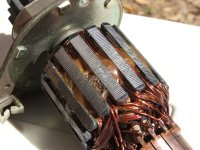alchemysa
Veteran Member
Hello Gentlemen. This is the armature from the starter motor of a Stihl Viking ride-on mower with a B&S 18hp Intek single cylinder engine. The starter has always seemed 'weak' but now its unable to rotate the engine past the compression stroke, even when I've connected a fully charged battery directly to the starter with jumper leads.
There was a bit of muck on the bushes and commutator that I cleaned off. Apart from that it looked OK except for some pitting in the hard epoxy stuff between the windings. You can see it in the picture. There's about four pitted areas like this around the armature. The pitting doesn't look black and burnt and it doesnt appear to go right down to the windings. The windings themselves also look clean and healthy. But is the pitting fatal?
Is there some way to test the windings with a multimeter. The starter is here at home, but the mower is at the shack, 300ks away, so I'd like to establish whether this needs to be replaced before I head down there again. Thanks for any advice.
There was a bit of muck on the bushes and commutator that I cleaned off. Apart from that it looked OK except for some pitting in the hard epoxy stuff between the windings. You can see it in the picture. There's about four pitted areas like this around the armature. The pitting doesn't look black and burnt and it doesnt appear to go right down to the windings. The windings themselves also look clean and healthy. But is the pitting fatal?
Is there some way to test the windings with a multimeter. The starter is here at home, but the mower is at the shack, 300ks away, so I'd like to establish whether this needs to be replaced before I head down there again. Thanks for any advice.
